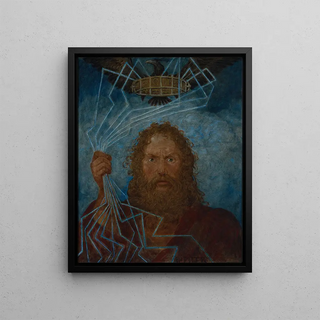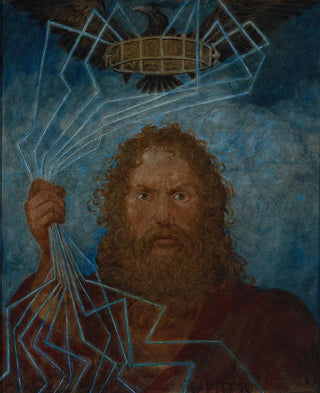Art print | Jupiter donne - Hans Thoma


View from behind

Frame (optional)
In the rich and complex universe of art history, some works stand out for their ability to capture the very essence of mythology while evoking deep emotions in the viewer. "Jupiter donne" by Hans Thoma is undoubtedly one of these remarkable creations. This piece, both majestic and delicate, transports us to a world where deities intertwine with human concerns. Through this representation, Thoma succeeds in establishing a dialogue between the divine and the earthly, inviting us to reflect on the relationships between humans and gods. Contemplating this work, one feels a shiver of wonder, as if witnessing a suspended moment in time where mythology comes to life before our eyes.
Style and uniqueness of the work
Hans Thoma's style is characterized by a harmonious fusion of realism and idealism, which is vividly expressed in "Jupiter donne." The artist, with undeniable mastery of colors and forms, manages to create an atmosphere that is both serene and dynamic. The figures are beautifully proportioned, while the drapery of the clothing seems almost tangible, giving a tactile dimension to the scene. Light plays a crucial role in this composition, illuminating the faces with a softness that evokes the benevolence of the god Jupiter. Every detail, from the expressions of the characters to the surrounding natural elements, contributes to the visual storytelling, making the work not only aesthetic but also deeply symbolic. Thoma succeeds in establishing a strong emotional connection, allowing the viewer to fully immerse themselves in this mythological representation.
The artist and his influence
Hans Thoma, an emblematic figure of 19th-century German art, knew how to establish himself through his unique style and his ability to incorporate folkloric elements into his works. Influenced by Romanticism and symbolism, he sought to express profound ideas through mythological themes and popular stories. His artistic approach is distinguished by a particular sensitivity towards nature and traditions, enabling him to create works that resonate with touching authenticity. "Jupiter donne" fits within this lineage, bearing witness to his desire

Matte finish

View from behind

Frame (optional)
In the rich and complex universe of art history, some works stand out for their ability to capture the very essence of mythology while evoking deep emotions in the viewer. "Jupiter donne" by Hans Thoma is undoubtedly one of these remarkable creations. This piece, both majestic and delicate, transports us to a world where deities intertwine with human concerns. Through this representation, Thoma succeeds in establishing a dialogue between the divine and the earthly, inviting us to reflect on the relationships between humans and gods. Contemplating this work, one feels a shiver of wonder, as if witnessing a suspended moment in time where mythology comes to life before our eyes.
Style and uniqueness of the work
Hans Thoma's style is characterized by a harmonious fusion of realism and idealism, which is vividly expressed in "Jupiter donne." The artist, with undeniable mastery of colors and forms, manages to create an atmosphere that is both serene and dynamic. The figures are beautifully proportioned, while the drapery of the clothing seems almost tangible, giving a tactile dimension to the scene. Light plays a crucial role in this composition, illuminating the faces with a softness that evokes the benevolence of the god Jupiter. Every detail, from the expressions of the characters to the surrounding natural elements, contributes to the visual storytelling, making the work not only aesthetic but also deeply symbolic. Thoma succeeds in establishing a strong emotional connection, allowing the viewer to fully immerse themselves in this mythological representation.
The artist and his influence
Hans Thoma, an emblematic figure of 19th-century German art, knew how to establish himself through his unique style and his ability to incorporate folkloric elements into his works. Influenced by Romanticism and symbolism, he sought to express profound ideas through mythological themes and popular stories. His artistic approach is distinguished by a particular sensitivity towards nature and traditions, enabling him to create works that resonate with touching authenticity. "Jupiter donne" fits within this lineage, bearing witness to his desire






